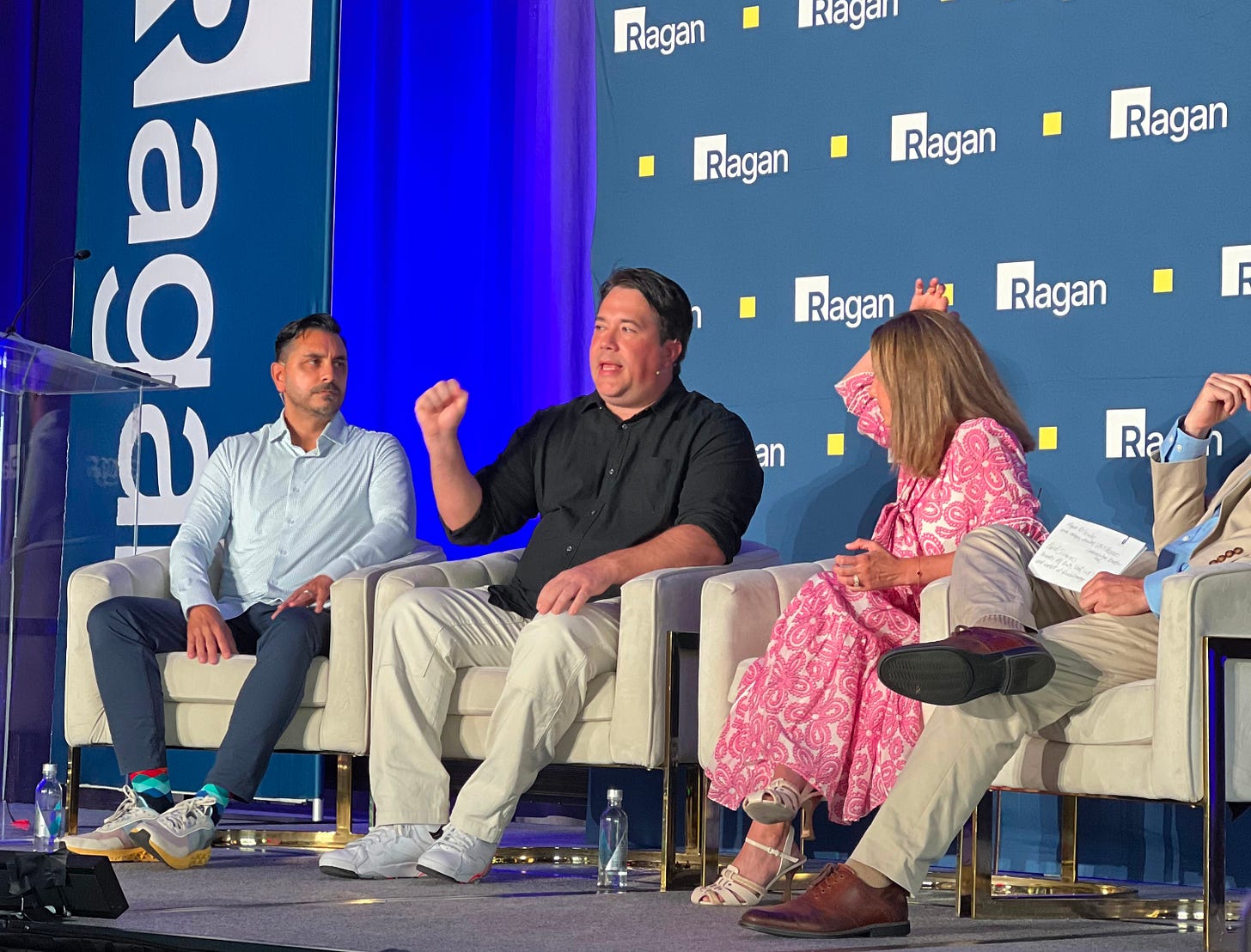Gritty, Unsexy, Unglamorous, & the Most Effective Comms Spend: It's Internal Comms!
Earned media, paid media, social media – sure, whatever. If you’re looking for the biggest bang for your buck, focus those comms dollars on your most important demographic: your own people.
Left to right: Joey Levi (LumApps), Yours Truly, Megan DiSciullo (PwC), and Matthew Kinsman (Ragan)
As I draft this, it’s been two weeks since Ragan’s Employee Experience Conference in Nashville where I was fortunate to be a part of a panel on that included Megan DiSciullo from PwC and Joey Levi from LumApps, moderated by Ragan’s Chief Content Officer Matthew Kinsman. Our panel, Using Generative AI to Enhance the Employee Experience, was enjoyable and, I hope, informative.
But I’m a little AI’ed out from all the week’s conversations. Frankly, the topic I feel more compelled to write about is the overarching theme of the event: “employee experience”, “engagement”, “change management” – all phrases used to describe that big, amorphous blob of our industry we colloquially refer to as internal communications.
Internal comms has been a passion for me since I left journalism 12 years ago and started doing this job. One of my first leadership roles was heading an agency-of-record team whose chief priorities were to protect a multinational blue-chip QSR brand and guide it through a pair of complex financial transactions that effectively doubled its size in a couple short years.
During this time, about three-quarters of my billable hours went to some form of internal comms remit. While other teams at my agency were doing couture runway shows on Miami Beach, staffing swanky awards shows, and hobnobbing with the glitterati, my working group could usually be found hunkered down and embedded in some open-concept, semi-private makeshift workspace, drilling down on strategy.
A Burgeoning Need for Brands
Our business would not have survived its early days without the gritty, unsexy, and anything-but-glamorous work of internal comms that buoyed us back then. As our big client’s culture changed post-transaction and the ground shifted below the feet of its stakeholders, our work satisfied a crucial need for them.
If I learned anything in Nashville, it’s that the need has only grown.
Walking through the well-attended Ragan event and talking to the internal comms practitioners whose bosses deemed their professional development important enough to shell out for airfare and a room at the Four Seasons, I’m reminded of why I left newsrooms for agency life. These young professionals might not realize it, but they are refreshingly well-provisioned in their careers. There are resources and attention being paid to their development. The people who make budget decisions at their companies have deemed their internal comms work a priority worthy of investment.
The difference with early-career journos couldn’t be starker. Being in the media in 2024 is a feast-or-famine proposition. If you’re not fortunate enough to be at an outlet whose business model is somehow flying above the fray (e.g. backed by VC or legalized gambling, owned by a billionaire, a tech-content play that’s part of a larger complex financial transaction, or literally the New York Times) nobody is sending you to the Four Seasons for a professional development conference.
Public Relations vs. Media Relations
As long as there is a public, Public Relations will matter. But the specific subgenre of Media Relations is dwindling in lockstep with the media itself. Most pitching happens on a local or regional level, but in 2023 an average of 2.5 local newspapers closed each week. The ranks of professionals in journalism shrank by 43,000 during the past decade.
The shrinking news hole affects TV and radio stations as well, as mergers and consolidation result in more serialized licensed (read: cheaper) content, supplanting valuable local airtime for the types of stories we pitch.
And here’s the dirty secret no one wants to talk about — let’s assume, even with the challenges of the modern media environment, you have a strong pitch for a compelling story, and you’re able to find one of those few reporters on the endangered species lists to write it up and get it published. Let’s say you even get it on the front page, or somehow it leads the 11 o’clock a-block. You’re still talking about an outlet whose reach – even including digital – is a fraction of what it once was, driving nowhere near the same results in earned media impact.
But you know, whatever, the death of local/regional media is a story that’s been told a million times since before my old ass even entered the workforce. This post is about a sector in communications that’s fresh, thriving, and a point of focus.
Internal Engagement is the Coin of the Realm
As there become fewer outlets to tell their stories, and as they become increasingly unapproachable and insular to the general public, brands are going to need an internal comms strategy that effectively shares their vision, mission and wins across their organizations.
These strategies don’t come out of a box; in fact, no two internal comms plans are even close to the same. They’re as diverse as the groups they seek to engage.
But there are some common guiderails you can use beyond just ensuring your lists and org charts are up to date. I’ve put together about a hundred internal comms plans in my career (some of them even worked!) so here are a few recommendations:
Identify Your Stakeholders: Apart from being an obnoxious 2020s buzzword, the concept of stakeholders is critical when assembling an internal comms plan. Don’t be so quick to conflate “stakeholders” with “employees”; they can also include directors, investors, contractors, vendors, tenants, neighbors or franchisees. Anyone invested in your success is a stakeholder and should be part of your internal comms plan.
Get Executive Buy-In: Shouting into the void is just as pointless an internal comms strategy as it is with external comms. Identify a voice or voices who will be the spearpoint for your strategy. Enlist the sponsorship (or at least tacit cosigning) of your executive team – the higher up the better. Position them as avatars for what’s happening organizationally, give them the tools to be effective communicators, and carve out time to let them cook. Make it worth their while and internal comms won’t be synonymous with a chore on their to-do list.
Leverage Your Internal Influencers: Everything mentioned in recommendation No. 2, but this time focused on well-regarded internal influencers with soft skills. Find the manager/director level folks who are leaders, who are well-liked, who are strong communicators plugged into the corporate culture. Make them your “Brand Ambassadors” and empower them to not just share information downward to their colleagues, but to collect and report feedback upwards to leadership. A strong Internal Brand Ambassador program can be a huge driver of engagement, but it has to be a two-way street.
Embrace Multimedia: If I use the phrase “pivot to video” in this post I might just trigger some theoretical algorithmic limit for obnoxious buzzwords, so I’ll avoid it. That said, most current metrics available to us suggest that video has surpassed text as an effective method of communicating. This is doubly true for workforces that include non-traditional “knowledge workers” (ugh, another one) who spend their hours on their feet, behind the steering wheel, or operating specialized equipment. I’ve had a lot of success in recent years launching internally focused podcasts for brands that feature significant blue collar work populations, as audio content is easier to fit into their busy and demanding days.
Don’t Fracture Your Hub: Sometime around 20-25 years ago, your organization probably dumped a whole bunch of time, money and energy into building an “intranet”. Since then, you’ve probably relaunched, rebranded or migrated it multiple times. You probably don’t even call it an “intranet” anymore. Whatever you call it, this place is your hub. It’s the one-stop-shop for anything your people need to know. Don’t create another one. Don’t make your people have to check in on multiple platforms, pages or inboxes. Keep one comprehensive place to house it all.
Email Ain’t It: This one is more tactical, but if you can, steer your content away from long, wordy, over-designed email newsletters. Everything we know about how people consume content informs the idea that we have less appetite for consuming information this way. Instead, along with multimedia (recommendation No. 4) use infographics, maps, displays, environmental branding, desk drops – basically anything that will cut through the mundanity of the inbox. Email is still important and should be a part of the strategy, but it ain’t it.
Use Your Inside Voice to Retrofit Your Best Stories: I continue to be surprised by how many clients I engage with who send out press release after press release – to varying degrees of success – but fail to share their contents with their internal stakeholders. No reporter will beat the drum louder or more effectively than your own people. Share your wins internally. Maybe consider prioritizing internal audiences over media (sacrilege, I know!) by sharing select information internally before sending a media alert. “Oh, but DQ, what if one of my people leaks it to the media before we have a chance to share it?” Uhm, great? Isn’t that what you wanted anyway? Just be sure the message is in a form that is appropriate for mass consumption, and maybe you don’t even need to send a press release.
Celebrate & Recognize: Recognition is the cheat-code for any internal comms strategy. It’s catnip, immediate engagement, a comfy setting to tell the best stories your brand can tell. Don’t compartmentalize recognition into “Recognition Time”, shunted off to the end of staff meetings. Instead, integrate it into everything – comms, town halls, videos, all corporate communications should feature someone who did something the right way, and an implicit call-to-action for more people to be like them.
These are pretty simple strategic suggestions and, again, they won’t all work for every organization. If you are one of the sharp internal comms minds I met in Nashville, much of this might even seem remedial.
But you would be shocked at how many organizations I encounter who still either don’t subscribe to these fundamentals or entirely disregard their most important demographic – their people.
Don’t let that be you.




